
Verona is a city on the River Adige in Veneto, Italy, with 258,031 inhabitants. It is one of the seven provincial capitals of the region, and is the largest city municipality in the region and in northeastern Italy. The metropolitan area of Verona covers an area of 1,426 km2 (550.58 sq mi) and has a population of 714,310 inhabitants. It is one of the main tourist destinations in Northern Italy because of its artistic heritage and several annual fairs and shows as well as the opera season in the Arena, an ancient Roman amphitheater.
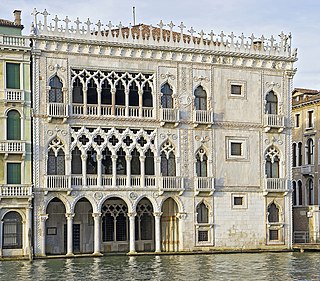
The Ca' d'Oro, or Palazzo Santa Sofia, is a palace on the Grand Canal in Venice, northern Italy. Ca' d'Oro or Cadoro translates to "House of Gold" or "Golden House" in English because of the gilt and polychrome external decorations that once adorned its walls. It was designed by Marino Contarini and later restored by Baron Giorgio Franchetti. In 1927, the building was converted into a museum and since then has been known as the Galleria Giorgio Franchetti alla Ca' d'Oro.

Michele Sanmicheli, sometimes also transcribed as Sammicheli, Sanmichele or Sammichele, was an Italian architect and urban planner who was a citizen of the Republic of Venice.

The Porta del Popolo, or Porta Flaminia, is a city gate of the Aurelian Walls of Rome that marks the border between Piazza del Popolo and Piazzale Flaminio.
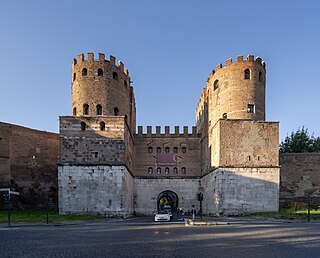
The Porta San Sebastiano is the largest and one of the best-preserved gates passing through the Aurelian Walls in Rome (Italy).
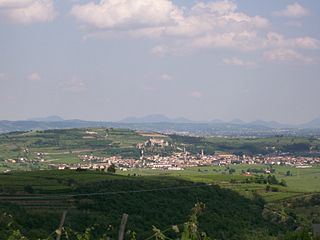
Soave is a small comune of the Veneto region in the Province of Verona, northern Italy, with a population of roughly 6,800 people.

Verona Cathedral is a Roman Catholic cathedral in Verona, northern Italy, dedicated to the Blessed Virgin Mary under the designation Santa Maria Matricolare. It is the episcopal seat of the Diocese of Verona.
The Walls of Padua are a complex of defensive works around the Italian city of Padua, designed to defend it from hostile attack. It was built in 4 phases.

Porta Borsari is an ancient Roman gate in Verona, northern Italy.

Porta Romana is a former city gate of Milan, Italy. In its present form, the gate dates back to the 16th century Spanish walls of Milan. Its origins can be traced further back to the Roman walls of the city, which had a corresponding "Roman Gate" roughly in the same area. Porta Romana was the first and the main imperial entrance of the entire city of Milan, as it was the starting point of the road leading to Ancient Rome. According to a survey conducted by Scenari Immobiliari in 2020, this area is in first place in the ranking of the neighborhoods that offer the best liveability in Milan.

Porta Magenta, formerly known as Porta Vercellina, was one of the city gates of Milan, Italy. The gate was established in the 9th century, with the Roman walls of the city; it was moved with the medieval and Spanish walls, and was finally demolished in the 19th century. The phrase "Porta Magenta" is now used to refer to the district ("quartiere") where the gate used to be; the district is part of the Zone 7 administrative division of Milan, west of the city centre.
Borsari is a surname. Notable people with the surname include:

Porta Palio is a gate or portal of the former outer medieval walls of the city of Verona, Italy. It was designed and built during 1550–1561 by the architect Michele Sanmicheli.
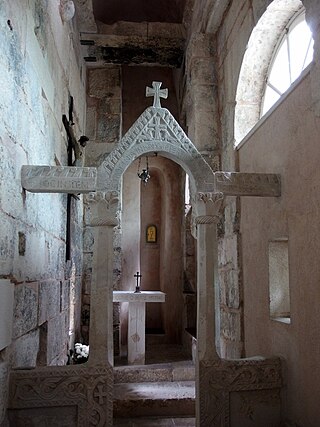
St. Martin's Church is a Roman Catholic church in Split, Croatia. Built into a small space within the ancient Golden Gate of Diocletian's northern wall, it is one of the oldest churches in the city. St. Martin's Church is one of Split's tourist attractions and is known for its fine 11th century chancel screen. It is currently in the care of the Dominican sisters, who have a monastery next door. The church itself is open to public visits.

Porta Torre is a main fortified tower located in the town of Como, in Lombardy. It is 40 meters high and it was built in 1192, to defend the main entrance of the city.

San Matteo con Cortile is a former Roman Catholic church in the historic centre of Verona, Italy dedicated to Matthew the Apostle. It was constructed in the medieval period on the site of a Roman temple of Janus. The building was deconsecrated in 1806 and it was used for various purposes, and it currently houses a restaurant and pizzeria.

Porta Nuova is a gateway to the historic center of Verona, built between 1532 and 1540. It was designed by architect Michele Sanmicheli. Giorgio Vasari remarked on the gateway in his work Le vite de' più eccellenti pittori, scultori e architettori, stating that it was "never before any other work of more grandeur or better design."

The Roman walls of Verona were an important defensive curtain wall equipped with numerous towers and monumental gates, built in several successive construction phases starting in the late Republican age and continuing through the early Roman-Germanic kingdoms.
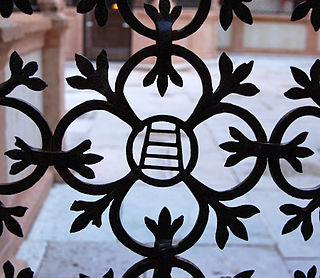
The monuments of Verona are a vast number of architecturally, archaeologically, historically, and artistically significant cultural assets that characterize the city of Verona. Precisely because of the richness of its monuments and the urban evolution that has developed seamlessly over the centuries, UNESCO declared the city a World Heritage Site in 2000.


















